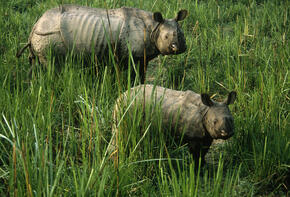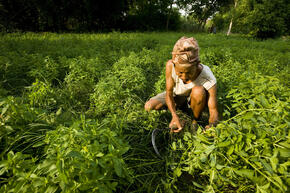Himalayas Baby Great One Horned Rhino With a Person
Increasing Populations
WWF seeks to create three new populations of at least 10 greater one-horned rhinos each in the next five years. The Indian state of Assam is home to the largest population of greater-one horned rhinos, with more than 90% in Kaziranga National Park. Since 2008, the Indian government, along with WWF and other partners, has translocated 18 rhinos from Kaziranga National Park and Pobitora Wildlife Sanctuary to Assam's Manas National Park on the India-Bhutan border. As of 2017, Manas was home to 29 rhinos. In India, WWF aims to expand the number of greater one-horned rhinos to 3,000—spread out over seven protected areas—by 2020. In Nepal, the goal is to increase the rhino population from 645 to 800 individuals in the coming years. In March 2016, five rhinos were translocated from Chitwan National Park to the Babai Valley of Bardia National Park in Nepal. Two of the translocated females gave birth within a few months—an encouraging sign that they are adjusting well to the new habitat.
Monitoring and Protection
WWF helps to strengthen security measures and provides critical support for anti-poaching efforts at key sites including Kaziranga National Park and Pobitora and Laokhowa-Burachapori Wildlife Sanctuaries. We also invest in improving rhino monitoring to collect data and measure progress toward achieving rhino conservation goals, assess the reproductive health and growth rate of populations, and make the right decisions to keep rhino numbers growing at a rate of at least 3%.
Restoring Landscapes

As rhino populations increase, they need additional space to live and breed. WWF and partners restore rhino habitat in Nepal to increase rhino numbers and improve connectivity between protected areas. Chitwan National Park's population of greater one-horned rhinos is the second largest population of this species in the world, after India's Kaziranga National Park. In Kaziranga National Park, WWF works to secure habitat corridors so that rhinos have access to higher areas outside of the park during annual floods.
Working with Local Communities

Planting mentha (mint) helps reduce human-wildlife conflict.
The protected areas of India and Nepal, where rhinos reside, are surrounded by dense human populations. It is vital to ensure that communities that live around rhino reserves are sympathetic to, and benefit from, the rhinos in their midst. WWF supports several projects to improve local livelihoods, like the successful community-run Marmelous juice factory in Khata, Nepal. We help decrease conflict between people and rhinos by encouraging farmers to plant unpalatable species like mentha (mint) that generates money for the communities and supports community-based antipoaching operations.
Strengthening Law Enforcement
WWF partners with national governments to strengthen wildlife laws and their enforcement, and fund antipoaching equipment and operations in protected areas. In response to a poaching spike in Nepal in 2006, WWF increased the number of security posts from eight to 20. We also engaged ex-army and police to patrol vulnerable points outside protected areas. Local youth volunteered to guard individual rhinos through the night. WWF relayed the information collected by these allies to key government departments so they could take action where needed. Nepal's concerted efforts to protect rhinos has resulted in the country achieving four periods of 365 days each of zero rhino poaching since 2011. Today, more than 645 one-horned rhinos live in Nepal—the highest number recorded in the country so far. In 2015, Nepal hosted the first symposium focused on getting to zero poaching. Under Nepal's leadership, delegates from more than 13 Asian countries shared best practices, tools, and technologies that can be used to respond to the poaching crisis.
Tackling Illegal Wildlife Trade
WWF and TRAFFIC, the wildlife trade monitoring network, work to stop trafficking of rhino horn by funding antipoaching patrols and supporting intelligence networks in strategic locations to prevent rhinos from entering black markets in Asia. We support the South Asia Wildlife Enforcement Network (SAWEN) so that regional governments can combine information and resources. This includes using early warning systems, investing in effective legislation, and improving enforcement of policies and laws.
Himalayas Baby Great One Horned Rhino With a Person
Source: https://www.worldwildlife.org/species/greater-one-horned-rhino
0 Response to "Himalayas Baby Great One Horned Rhino With a Person"
Post a Comment